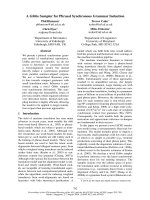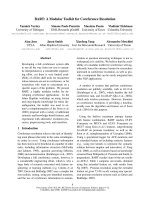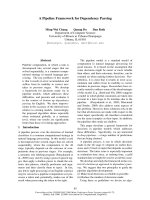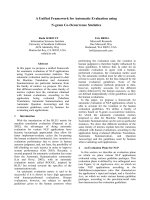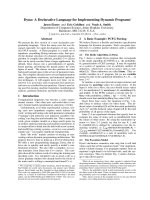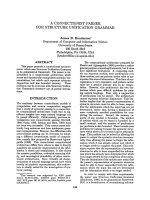Báo cáo khoa học: "A Compositional Semantics for Focusing Subjuncts" doc
Bạn đang xem bản rút gọn của tài liệu. Xem và tải ngay bản đầy đủ của tài liệu tại đây (414.56 KB, 8 trang )
A Compositional Semantics for Focusing Subjuncts
Daniel Lyons*
MCC
3500 West Balcones Center Drive
Austin, TX 78759, USA
lyons~mcc.com
Graeme Hirst
Department of Computer Science
University of Toronto
Toronto, Canada MSS
1A4
gh~ai.toronto.edu
Abstract
A compositional semantics for focusing subjuncts
words such as only, even, and also is developed
from Rooth's theory of association with focus. By
adapting the theory so that it can be expressed in
terms of a frame-based semantic formalism, a seman-
tics that is more computationally practical is arrived
at. This semantics captures pragmatic subtleties by
incorporating a two-part representation, and recog-
nizes the contribution of intonation to meaning.
1 Introduction
Focusing subjuncts such as only, even, and also
are a subclass of the sentence-element class of ad-
verbials (Quirk et al., 1985). They draw attention
to a part of a sentence the focus of the focusing
subjunct which often represents 'new' information.
Focusing subjuncts are usually realized by adverbs,
but occasionally by prepositional phrases. Focusing
subjuncts emphasize, approximate, or restrict their
foci. They modify the force or truth value of a sen-
tence, especially with respect to its applicability
to
the focused item (Quirk et al., 1985, §8.116).
1.1 The problem with focusing
subjuncts
There are several reasons why developing any se-
mantics for focusing subjuncts is a difficult task.
First, focusing subjuncts are 'syntactically
promiscuous'. They can adjoin to any maximal pro-
jection. They can occur at almost any position in a
sentence.
Second, focusing subjuncts are also 'semantically
promiscuous'. They may focus (draw attention to)
almost any constituent. They can precede or fol-
low the item that they focus, and need not be adja-
cent to this item. The focus need only be contained
somewhere within the syntactic sister of the focus-
ing subjunct. Because of this behavior, it is difficult
to determine the intended syntactic argument (ad-
junct) and focus of a focusing subjunct. Sentences
*The work described in this paper was done at the University
of Toronto.
such as those in (1) can be ambiguous, even when
uttered aloud with intonational effects. 1
(1) 1. John could also (SEE) his wife from the
doorway (as well as being able to talk to
her).
2. John could also see (his WIFE) from the
doorway (as well as her brother).
3. John could also see his wife (from the
DOORway) (as well as from further inside
the room).
4. John could also (see his wife from the
DOORway) (as well as being able to do
other things).
Third, the location of intonational stress has an
important effect on the meaning of a sentence con-
taining a focusing subjunct. Sentences may be
partly disambiguated by intonational stress: inter-
pretations in which stress falls outside the intended
focus of the focusing subjunct are impossible. For
example, the sentence
(2) *John could also see (his wife) from the
DOORway.
is impossible on the indicated reading, since stress
on door cannot confer focus on his wife. On the other
hand, stress does not help to disambiguate between
readings such as (1.3) and (1.4).
Fourth, focusing subjuncts don't fit into the slot-
filler semantics that seem adequate for handling
many other sentence elements (see Section 1.3)~ At
best, their semantic effect is to transform the se-
mantic representation of the constituent they modify
in some predictable compositional way (Hirst, 1987,
p. 72).
Finally, focusing subjuncts carry pragmatic "bag-
gage". The meaning of a focusing subjunct includes
distinct asserted and non-asserted parts (Horn,
1969), (Karttunen and Peters, 1979). For example,
1 In the example sentences in this paper, small capitals de-
note intonational stress. Angle brackets 0 enclose the focus
of a focusing subjunct and square brackets [ ]
set off the
con-
stituent to which the focusing subjunct adjoins. Unacceptable
sentences are preceded by an asterisk.
54
(3) asserts (4.1) but only
presupposes
(4.2) (Horn,
1969):
(3) Only Muriel voted for Hubert.
(4) 1. No one other than Muriel voted for Hu-
bert.
2. Muriel voted for Hubert.
Analogously, (5) asserts (6.1) and presupposes (6.2)
(Karttunen and Peters, 1979):
(5) Even Bill likes Mary.
(6) 1. Bill likes Mary.
2. Other people besides Bill like Mary; and
of the people under consideration, Bill is
the least likely to like Mary.
The precise status of such pragmatic inferences is
controversial. We take no stand here on this issue, or
on the definition of "presupposition". We will simply
say that, for example, (4.1) is due to the asserted
meaning of
only,
and that (4.2) is produced by the
non-asserted meaning of
only.
1.2 Requirements of a semantics for
focusing subjuncts
We desire a semantics for focusing subjuncts that
is compositional (see Section 1.3), computation-
ally practical, and amenable to a conventional,
structured, near-first-order knowledge representa-
tion such as frames. It must cope with the se-
mantic and syntactic problems of focusing subjuncts
by being cross-categorial, being sensitive to in-
tonation, and by distinguishing asserted and non-
asserted meaning. By
cross-categorial
semantics we
mean one that can cope with syntactic variability in
the arguments of focusing subjuncts.
We will demonstrate the following:
• Intonation has an effect on meaning. A focus
feature is useful to mediate between intona-
tional information and meaning.
• It is desirable to capture meaning in a multi-
part semantic representation.
• An extended frame-based semantic representa-
tion can be used in place of higher-order logics
to capture the meaning of focusing subjuncts.
1.3 Syntactic and semantic frameworks
In this paper, we will use a compositionM, frame-
based approach to semantics. Focusing subjuncts
have been thought difficult to fit into a composi-
tional semantics because they change the meaning of
their matrix sentences in ways that are not straight-
forward.
A compositional semantics is characterized by
the following properties:
• Each word and well-formed syntactic phrase is
represented by a distinct semantic object.
• The semantic representation of a syntactic
phrase is a systematic function of the represen-
tation of its constituent words and/or phrases.
In a compositional semantics, the syntax drives the
semantics. To each syntactic phrase construction
rule there corresponds a semantic rule that speci-
ties how the semantic objects of the constituents are
(systematically) combined or composed to obtain a
semantic object for the phrase. Proponents of com-
positionM semantics argue that natural language it-
self is for the most part compositional. In addition,
using a composition semantics in semantic interpre-
tation has numerous computational advantages.
The particular incarnation of a compositional se-
mantics that serves as the semantic framework for
this work is the frame-based semantic representa-
tion of Hirst's Absity system (Hirst, 1987, 1988).
Absity's underlying representation of the world is a
knowledge base consisting of frames. A frame is
a collection of stereotypical knowledge about some
topic or concept (Hirst, 1987, p. 12). A frame is
usuMly stored as a named structure having associ-
ated with it a set of slots or roles that may be as-
signed values or fillers. Absity's semantic objects
belong to the types in a frame representation lan-
guage called Frail (Charniak, 1981). Absity uses the
following types of semantic object:
• a frame name
• a slot name
• a frame determiner
• a slot-filler pair
• a frame description (i.e. a frame with zero or
more slot-filler pairs)
• eiLher
an instance
or
frame statement (atom or
frame determiner with frame description)
A frame determiner is a function that retrieves
frames or adds them to the knowledge base. A frame
description describes a frame in the knowledge base.
The filler of a slot is either an atom, or it is an in-
stance, specified by a frame statement, of a frame in
the knowledge base. In order to capture the mean-
ing of sentences containing focusing subjuncts, we
will augment Absity's frame-representation language
with two new semantic objects, to be described in
Section 3.3.
The notation Hirst uses for frames is illustrated in
Figure 1, which is a frame statement translation of
the sentence
(7) Ross washed the dog with a new shampoo.
The semantics we will outline does not depend on
any particular syntactic framework or theory. How-
ever, we choose to use Generalized Phrase Structure
Grammar (GPSG) (Gazdar et al., 1985), because
this formalism uses a compositional semantics that
55
(a ?u (wash ?u
(agent=(the
?x
(person
?X (propername Ross))))
(patlent=(the
?y (dog ?y)))
(instrument=(a ?z (shampoo ?z (age=new))))
))
Figure 1: An Absity frame statement
resembles Montague grammar (Montague, 1973). A
central notion of GPSG that we will make use of is
that of the features of a syntactic phrase. A feature is
a piece of linguistic information, such as tense, num-
ber, and bar level; it may be atom-valued or category-
valued.
1.4 Previous research
The groundwork for the analysis of focusing sub-
juncts was laid by Horn (1969). ttom describes
only (when modifying an NP) as a predicate tak-
ing two arguments, "the term ix] within its scope"
and "some proposition [Pz] containing that term"
(Horn, 1969, p. 99). The meaning of the predicate is
then to presuppose that the proposition P is true of
z, and to assert that x is the unique term of which P
is true: -,(~y)(y # z & Py). Even takes the same ar-
guments. It is said to presuppose (qy)(y # x & Py)
and to assert Px. Horn requires a different formula-
tion of the meaning of only when it modifies a VP.
Since his formulation is flawed, we do not show it
here.
Jackendoff's (1972, p. 242) analysis of even and
only employs a semantic marker F that is assumed to
be present in surface structure and associated with
a node containing stress. He calls the semantic ma-
terial associated with constituents marked by F the
focus of a sentence. Fie proposes a rule that states
that even and "related words" are associated with
focus by having the focus in their range. Differ-
ences between the ranges of various focusing adverbs
account for their different distributions (Jackendoff,
1972, pp. 249-250). For example:
Range of even: If even is directly dominated by a
node X, then X and all nodes dominated by X
are in its range.
Range of only: If only is directly dominated by a
node X, then X and all nodes that are both
dominated by X and to the right of only are in
its range.
That is, only cannot precede its focus (nor can just,
which has the same range), but even can:
(8) 1. *(JOHN) only gave Mary a birthday
present (no one else did).
2. (JOHN) even gave Mary a birthday
present (and so did everyone else, but
John was the person least expected to).
We will employ several aspects of Rooth's (1985)
domain selection theory. A key feature of the
theory is that only takes the VP adjacent to it in
S-structure as its argument (an extension of the the-
ory allows only to take arguments other than VPs).
Rooth describes technical reasons for this arrange-
ment (1985, p. 45). Among these is the fact that
focusing subjuncts can draw attention to two (or
more) items that, syntactically, do not together con-
stitute a well-formed phrase:
(9) John only introduced (BILL) to (SUE).
The prevailing linguistic theories allow a node (such
as a focusing subjunct) only one argument in the
syntactic or logical (function-argument) structures
of a sentence.
According to Rooth, the asserted meaning of
(10) John only [vP introduced BILL to Sue].
is "if John has a property of the form 'introduce y to
Sue' then it is the property 'introduce Bill to Sue'"
(Rooth, 1985, p. 44, p. 59). Rooth's theory would
produce the same translation, shown in (11.2), for
both sentence (10) and sentence (11.1).
(11) 1. John only introduced Bill to SUE.
2. VP[[P(john) & P 6 C]
* P = ^introduee'(bill, sue)]
P ranges over propositions, so (11.2) is a quantifica-
tion over propositions. C is bound 2 to the p-set of
the VP of whichever sentence's meaning (11.2) is in-
tended to capture. This p-set is "a set of properties,
which we think of as the set of relevant properties"
(Rooth, 1985, p. 43).
Different truth conditions for the two sentences
(10) and (11.1) obtain because their VPs have dif-
ferent p-sets: the computation of p-sets is sensitive
to intonational stress (actually to focus, which is sig-
nalled by stress; see below). The desired value for C
in the translation of (10) is the set of propositions of
the form "introduce y to Sue", namely propositions
satisfying (12.1). For the translation of (11.1), C is
the set of propositions of the form "introduce Bill to
y", that is, those satisfying (12.2).
(12) 1. AP3y[P = ^introdued(y, sue)]
2. AP3y[P = ^introduee'(bill, y)]
These result in the final translations (13.1) and
(13.2) respectively for sentences (10) and (11.1):
(13)
1. Vy[introducd(john, y, sue) + y=bilO
2. Vy[introduce' (john, bill, y) + y=sue]
2 The mechanism of this binding relies on the translation being
a formula of which (11.2) is a reasonable simplification; see
(Rooth, 1985, p. 59).
56
The formula (13.1) corresponds to the gloss of the
meaning of (10) given above. (13.2) is to be inter-
preted as meaning:
"if
John has a property of the
form 'introduce Bill to y' then it is the property 'in-
troduce Bill to Sue'".
The p-set of a complete sentence is a set of "rel-
evant propositions". Rooth defines it recursively,
from the p-sets of its constituents (Rooth, 1985,
p. 14) (the "model" is a Montague-style formal
model):
(14)
Let a be a constituent with translation a ~. The
p-set of a is:
1. if a bears the focus feature, the set of ob-
jects in the model matching a ~ in type;
2. if a is a non-focused non-complex phrase,
the unit set {a'};
3. if a is a non-focused complex phrase,
the set of objects that can be obtained
by picking one element from each of the
p-sets corresponding to the component
phrases of a, and applying the semantic
rule for a to this sequence of elements.
In other words, the p-set of a sentence consists essen-
tially of all propositions that are "like" the propo-
sition that it asserts, except that the focused con-
stituent in the proposition is replaced by a variable. 3
We will adopt Rooth's definition of the meaning
of
only:
A sentence containing
only
that (without
only)
has logical form a:
(15) 1.
asserts
that any "contextually relevant"
proposition P whose extension is true
is
the proposition a;
2. has a as part of its
non.asserted
meaning.
(Rooth, 1985, p. 120).
Our analogous definition of
even
is this: A sentence
containing
even
that (without
even)
has logical form
a:
(16) 1.
asserts a;
2. conveys the non-asserted inference that
there are other "contextually relevant"
propositions, besides a, that are true.
2 Devices used to solve the problems
Our semantics (which is described in more detail by
Lyons (1989)) employs devices described in the fol-
lowing sections.
2.1 The focus feature
Following Jackendoff, we propose that focus is a bi-
nary feature, similar to (say) gender and number,
aThe notion that the meaning of
only and even can
be defined
in terms of a base form (such as
"John
introduced y to Sue")
was also noted by Kaxttunen and Peters (1979) and McCord
(1982).
that is either present or absent on every constituent
at surface structure. 4 Focus is initially instantiated
onto the leaves of the tree that represent intona-
tionally stressed words. The only realization of the
focus feature that we accommodate is intonational
accent; however, our theory can easily be extended
to allow for other overt realizations of focus, includ-
ing other intonational effects (e.g. (Hirschberg and
Pierrehumbert, 1986)). Focus is
optionally
and non-
deterministically percolated up the syntax tree, to
any node from its rightmost daughter (rightmost be-
cause stress manifests itself only at the
end
of the
focused constituent (Anderson, 1972)). The non-
determinism of the percolation of focus is responsible
for ambiguity in the interpretation of sentences with
focusing subjuncts. How far the focus feature per-
colates up determines how wide a focus is attributed
to the focusing subjunct:
(17) 1. John also read the book (from the
LIBRARY) (as
well as the one from the
store).
2. John also read (the book from the
LIBRARY) (as
well as the newspaper).
3. John also Iread the book from the
LIBRARY) (as
well as completing his as-
signment).
The ambiguous interpretations of a sentence with a
focusing subjunct belong to an ordered set in which
each reading has a wider focus for the focusing sub-
junct than the previous one.
2.2 Relevant propositions
Our semantics employs a computational analogue of
Rooth's p-sets for a frame representation. Our p-
set for a constituent is computed compositionally,
along with the semantic representation, in tandem
with the application of the syntactic rule used to
build the constituent. The p-set turns out to be an
object in the frame representation that is like the
semantic assertion derived for the constituent, but
lacking restrictive information associated with any
focused components.
2.3 Two-part semantics
In addition to p-sets,
two
semantic expressions are
computed for each constituent during the interpre-
tation of a sentence. One expression represents as-
serted meaning, and the other, non-asserted mean-
ing.
4 This feature is what Jackendoffcalls the F marker, but is dif-
ferent from what he calls "focus". Note that we use the term
focus of a focusing subjunct to stand for a distinct con-
cept: the item to which a focusing subjunct draws attention
to, or
focuses.
This is the semantic material that corresponds
to a stressed word or to a constituent containing one.
57
2.4 Linguistic
features
Focus is marked as a binary feature on all syntactic
constituents. The semantic rules use this informa-
tion when constructing semantic expressions for con-
stituents. Because the focus feature need not perco-
late all the way up to the level of the constituent
that is adjacent to the focusing subjunct in the syn-
tax tree, we have found it useful to employ a second
feature,
focus.in,
that indicates whether or not any
sub-phrase is focused. The restriction that a focus-
ing subjunct adjoins only to a phrase containing fo-
cus is implemented by requiring the adjunct phrase
to be (focus-in +).
Range
(see Section 1.4) is implemented as two bi-
nary features,
range-right
and
range-left,
that indi-
cate whether or not a given focusing subjunct can
adjoin to phrases to its right and left, respectively.
(Some words, like
even,
have both features.)
2.5 Sentential
operators
Rooth applies his
even
and
only
operators to the logi-
cal form of the constituent that is the syntactic sister
of the focusing subjunct. So, for example, in the VP
(18.1),
only
transforms the expression
wash'(dog),
which is the translation of the VP argument of
only,
into the A-expression (18.2).
(18) 1. only [vp washed the (DOG)]
2. AxVP[[VP & P
e C']
P = ^wash'(x, dog)]
For each focusing subjunct, Rooth must define a sep-
arate transformation for each different semantic type
of phrase that it may take as an argument. He de-
fines a basic
sentential
operator for each focusing
subjunct, and then derives the other operators from
these (Rooth, 1985, pp. 120-121).
Our approach is to instead define a
single
operator
for each focusing subjunct, essentially Rooth's basic
sentential operator. This operator takes the seman-
tic representation of a sentence as an argument and
produces another semantic representation of senten-
tial type. When sentential objects are not available,
as in the interpretation of [vp only VP], we delay the
application of the operator until such a point as fully
developed propositions, the semantic objects of sen-
tenees,
are
available. To do this, the grammar rules
"percolate" focusing subjunct operators up the syn-
tax tree to the S node. Our grammar employs the
feature
fs
to carry this latent operator. When the
interpretation of a sentence is otherwise completed,
a final step is to apply any latent operators, produc-
ing expressions for the sentence's asserted and non-
asserted meanings from expressions for its assertion
and its p-set.
Several pieces of evidence motivate this approach:
• As Rooth observed, in order to define a family of
cross-categorial operators for (say)
only,
a basic
operator must be defined that operates on an
expression of sentential type. The semantics of
focusing subjuncts actually seems to take place
at the sentence level.
Focusing subjuncts normally occur at most once
per
sentence.
Even granting the acceptability of
sentences containing several focusing subjuncts,
such sentences are clearly semantically compli-
cated.
The principal advantage of our approach is that
it constructs essentially the same final translation
of a sentence as Rooth's, but avoids using the A-
operator during the derivation of a semantic repre-
sentation that does not itself contain a A-operator.
This is desirable, as A-expressions would make the
frame representation language less tractable.
3 Details of the semantics
3.1 Semantic features
Three semantic objects are computed for and at-
tached to each syntactic constituent, in parallel with
the syntactic processing. The objects are of the
types defined in an Absity-like frame representation.
They are attached to a node as values of the fol-
lowing features (an approach motivated by Shieber
(1986)):
Assert:
The asserted meaning of the constituent, its
contribution to the sentence's
asserted mean-
ing. The value is computed the same way
that a Montague-style grammar would con-
struct a constituent's logical form from those
of its daughters. Figure 2 shows examples of
the rules to compute this value.
Presupp:
The constituent's contribution to the sen-
tence's
non-asserted meaning.
For all rules but
sentence rules, the presupp feature on the parent
node is undefined. In order not to commit our-
selves to the status of the non-asserted mean-
ings of focusing subjuncts, we reserve this fea-
ture for the non-asserted meanings introduced
by focusing subjunct operators (see below).
P-set:
A prototype of the semantic objects in the
node's p-set. All objects that match this object
are in the node's p-set. The algorithm for com-
puting p-sets distinguishes between two cases:
Case 1: If the parent node X (being con-
structed) is (focus +), its p-set is a variable
of the same type as the
assert
object.
Case 2: Otherwise, the p-set of X is con-
structed from the p-set values of the con-
stituent phrases in a manner exactly paral-
leling the construction of the
assert
feature.
58
Syntax rule Semantic
rule
S * XP[(assert (agent = a))], S = S[(assert (frame ~
(agent
= 4) sf-pairs))]
VP[(assert
(frame fl
sf-pairs))]
VP * V[2 (assert (frame ?t~))], VP = V[(assert (frame ?a (slotfl = ~)))1
NP[obj (assert (slot~ = ¢))]
PP * P[38 (assert slota)], PP = PP[(assert (slots = fl))l
NP[(assert fi)]
Figure 2: Examples of semantic rules for the assert feature
3.2 Application
of the focusing subjunct
operators
There is a syntactic rule whose sole purpose is to
support of the application of a sentential operator:
09) s H[(fs 4)1
S[fs 4] is specified as a non-initial category in the
grammar, if a ¢ "-". Therefore, the rule (19) must
apply in the derivation of any well-formed sentence
containing a focusing subjunct. The corresponding
semantic rule (20) applies a focusing subjunct oper-
ator to the semantic representation of the sentence.
(20) 1. Input:
S[(assert a), (p-set ~/), (fs 7)]
2. Output:
• If 7 = "-" then
S[(assert a), (p-set fl)]
• else
S[(assert
oplv(t~ ,
fi)),
(presupp op2,(tr, fl)),
(p-set fl)]
where oplv and op2v are the sentential operators for
the focusing subjunct 7 (see below).
3.3 The sentential operators
The sentential operators for
only
and
even
are given
below. (The one for
too
is the same as that for
even,
and those for the other focusing subjuncts are simi-
lar.)
(21) 1. oplontu(A, P) = if P then A
2. op2only (A, P) =
A
3. opl~,e,(A, P) = A
4. op2~ven(
(the
?x
frame-descrA),
(the ?y frame-descrP) )
= (anew ?y ¢?z (frame-descrP))
The form if
P then
A is a directive to the underly-
ing knowledge base to insert the rule that any frame
matching P is just the frame A, that is, A is the
unique frame matching P. This directive is a frame
implication. It is similar in character to a frame
determiner (Hirst, 1987), in that it is a function that
manipulates the underlying knowledge base.
The form
(anew
?y ~?X
frame-descrP)
is also a
new type of entity in the semantics. We treat it as a
frame determiner. It is a directive to the knowledge
base to retrieve or create a frame instance, ?y, that
matches
frame-descrP
but is
not
the frame instance
identified by the variable ?x. As with the frame
determiner (the ?x), such a frame instance ?y should
be inserted if not already present in the knowledge
base.
For example, the sentence (22.1) yields the ex-
pression (22.2) as its assertion and (22.3) as its
non-asserted meaning (other readings are possible
as well).
(22) 1. Ross only washed the DOG.
2. if (wash ?x (agent=Ross))
then
(wash
?x
(agent=Ross) (patient=dog)))
3.
(the
?x
(wash
?x
(agent=Ross)
(patient=dog)))
The frame instance (22.3) captures the semantic con-
tent of the sentence "Ross washed the dog". The
frame implication (22.3) is to be interpreted as the
rule that any wash frame in the knowledge base hav-
ing Ross as its agent must in addition have dog as
its patient.
A second example: sentence (23.1) yields assertion
(23.2) and non-asserted meaning (23.3).
(23) 1. Ross washed even the DOG.
2. (the ?x (wash ?x
(agent=Ross) (patient=dog)))
3.
(anew
?y ~?x
(wash
?y
(agent=Ross)))
The expression (23.3) affirms the existence of a
wash
instance ?y having agent
Ross
but that is a distinct
washing from ?z in (23.2), which has dog as its pa-
tient.
4 The implementation
IDEO (Interpreter Designed for
Even
and
Only)
is
a limited semantic interpreter that incorporates the
59
semantics for
even
and
only
described in Section 3.
The implementation is in Edinburgh C-Prolog, run-
ning under UNIX on a Sun-4 computer. Because the
authors did not have access to a working version
of Frail (see Section 1.3), IDEO runs on top of a
toy knowledge base, also implemented in C-Prolog,
whose retrieval language is (unfortunately) a syntac-
tic variant of Absity's.
A sample session with IDEO is follows below. In
this trace, output generated by the program or typed
by the user is shown in typewriter font. As the ex-
ample shows, IDEO accepts a sentence typed at the
keyboard and outputs four different things. Firstly,
it echoes the sentence in its internal Prolog format.
Secondly, the GPSG category obtained for the sen-
tence, which incorporates a parse tree for the sen-
tence, is displayed. For the sake of readability, IDEO
prints a simplified version of the category. Then, it
prints separately the semantic representation of the
sentence, which consists of several of the feature-
value pairs of the sentence category. Lastly, it dis-
plays a message about the success or failure of each
knowledge base function call resulting from process-
ing the semantic representation of the sentence. In
a question-and-answer system, these messages would
be replaced by generated English answers.
Please enter a sentence, follo.ed by a
carriage return, after the "I:" prompt.
J: Ross only washed the :dog.
The colon preceding the word dog tells IDEO that
the word isintonationally stressed.
>>>
Sa~ the sentence:
[ross. only. ,ashed. the. stress(dog).
period]
>>>
The category for this sentence is:
[Omitted due to space ~mitations.]
The significant piece of information in the
GPSG category is that the noun phrase [NP
the
stress(dog)]
is (focus +), but the verb phrase that
contains it is not.
>>> The semantic representation
is:
assert(
if frame(X, .ash) k slot(X, agent,
ross)
then frame(X, .ash)
k slot(X, agent,
ross)
slot(X, patient, Y)
k
framedet(the.
Y,
frame(Y, dog)))
presupp(framedet(a, X,
frame(X ash)
k slot(X, agent, ross)
k slot(X, patient. Y)
k framedet(the, Y, frame(Y, dog))))
p-set(framedet(a.
X,
frame(X, .ash) k slot(X, agent, ross)))
fs(only)
>>> OK? no
This semantic representation corresponds to the
reading in which the speaker means to assert that
Ross washed nothing else but the dog. The user
replies no to the prompt OK? to indicate that this is
not the reading he intends.
>>>
The category for this sentence is:
[Omitted due to space limitations.]
This time, a parse is returned in which the feature
(focus +) percolates up the parse tree to the entire
verb phrase [NP .ashed the stress(dog)],
>>> The semantic
representation is:
assert(
if slot(X, agent, ross)
then frame(X, .ash)
k slot(X, agent, ross)
k slot(X, patient, Y)
k
framedet(the,
Y,
frame(Y, dog)))
presupp(framedet(a, X.
frame(X, .ash) k slot(X, agent, ross)
slot(X, patient, Y)
k framedet(the, Y, frame(Y,
dog))))
p-set(framedet(a, X.
slot(X, agent, ross)))
fs(only)
>>> OK? yes
The user approves this semantic representation,
which corresponds to the reading in which the
speaker asserts that Ross did nothing but wash the
dog.
>>> Retrieved frame "dogl"
frame (dog1.
dog)
>>> Found frame
"washl"
frame (wash1, .ash)
slot(.ashl, agent, ross)
slot(.ashl, patient, dogl)
>>> Inserted rule "rulel"
if
slot(X, agent, ross)
then
X =
.ashl
The knowledge base now is constrained by the rule
rulel. This says that ira frame X satisfies the frame
description slot(X, agent, ross)(i.e, its agent is
ross), then it must be the frame ,ashl (a ,ash
frame whose patient slot is filled by dogl).
60
5
Conclusions
This paper summarizes work, details of which can be
found in (Lyons, 1989). The work represents a step
towards better understanding of focusing subjuncts
and of compositional semantics in general. The se-
mantics we have proposed allows focusing subjuncts
to be covered by a frame-based approach to semantic
interpretation, by virtue of its being compositional,
computationally practical, able to differentiate be-
tween asserted and non-asserted meaning, sensitive
to intonation, and eross-categorial. We have found
that:
• Focus and stress information can be used to ad-
vantage in a semantic interpreter.
• The hypothesis that focus may be optionally
percolated to a parent node from a daughter
explains the scope ambiguities observed in the
interpretation of focusing subjuncts.
• Rooth's method of obtaining the translation of
a focusing subjunct by using p-sets to select
"domains of quantification" can be adapted to
translating a sentence into a frame represents-
tion.
• Treating focusing subjuncts as operators on sen-
tential semantic forms makes this translation
possible.
• Semantically, focusing subjuncts are not just
passive objects for composition. We have shown
extensions to standard frame representations
that are required for the translation of focus-
ing subjuncts.
Acknowledgements
Both authors acknowledge the support of the Natural
Sciences and Engineering Research Council of Canada.
We are also grateful to Diane Horton, Brendan Gillon,
Barb Brunson, and Mark Hyan for discussions, com-
ments on earlier drafts, and general encouragement.
References
Anderson, Stephen R. (1972). How to get even. Lan.
guage, 48:893-906.
Charniak, Eugene (1981). A common representation for
problem-solving and language-comprehension infor-
mation. Artificial Intelligence, 16(3):225-255. Also
published as technical report CS-59, Department of
Computer Science, Brown University, July 1980.
Gazdar, Gerald, Klein, Ewan, Pullum, Geoffrey K., and
Sag, Ivan (1985). Generalized Phrase Structure
Grammar. Harvard University Press.
Hirschberg, Julia and Pierrehumbert, Janet (1986). The
intonational structuring of discourse. In 24 th An-
nual Meeting of the Association for Computational
Linguistics, Proceedings of the Conference. pages
136-143.
Hirst, Graeme (1987). Semantic Interpretation and the
Resolution of Ambiguity. Cambridge University
Pre88.
Hirst, Graeme (1988). Semantic interpretation and am-
biguity. Artificial Intelligence, 34(2):131-177.
Horn, Laurence R. (1969). A presuppositional analy-
sis of only and even. In Binnick, Robert I., Davi-
son, Alice, Green, Georgia, and Morgan, Jerry, edi-
tors, Papers from the Fifth Regional Meeting of the
Chicago Linguistics Society. Chicago Linguistic So-
ciety, pages 98-107.
Jackendoff, Ray S. (1972). Semantic Interpretation in
Generative Grammar. The MIT Press.
Karttunen, Lanri and Peters, Stanley (1979). Conven-
tional implicature. In Oh, Choon-Kyu and Din-
neen, David A., editors, Presupposition, volume 11
of Syntaz and Semantics. Academic Press, pages 1-
56.
Lyons, Dan (1989). A computational semantics for fo-
cusing subjuncts. Master's thesis, Department of
Computer Science, University of Toronto. Also
published as technical report CSRI-234.
McCord, Michael C. (1982). Using slots and modifiers
in logic grammars for natural language. Artificial
Intelligence, 18:327-367.
Montague, Richard (1973). The proper treatment
of quantification in ordinary English. In Hin-
tiklm, Kaarlo Jaakko Juhani, Moravcsik, Julius
Matthew Emil, and Suppes, Patrick Colonel, edi-
tors, Approaches to Natural Language: Proceedings
of the 1970 Stanford workshop on grammar and se-
mantics. D. Reidel, pages 221-242. Also in Thoma~
son, Richmond Hunt (ed.), Formal philosophy: Se-
lected papers of Richard Montague. Yale University
Press (1974): 247-270.
Quirk, Randolph, Greenbaum, Sidney, Leech, Geoffrey,
and Svartvik, Jan (1965). A Comprehensive Gram-
mar of the English Language. Longman.
Rooth, Mats Edward (1985). Association with Focus.
PhD thesis, Department of Linguistics, University
of Massachusets.
Shieber, Stuart M. (1986). An Introduction to
Unification-Based Approaches to Grammar. Cen-
ter for the Study of Language and Information.
61


